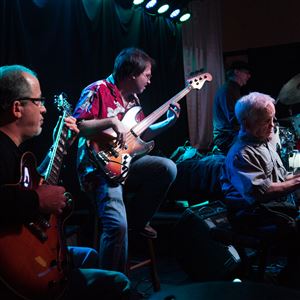If all goes well, Pittsburgh’s landmark jazz mecca, Crawford Grill No. 2, will be listed on the National Register of Historic Places by year’s end. Pennsylvania’s historic preservation board voted unanimously Tuesday to forward the nomination to the National Park Service.
That’s a big leap for a Hill District building closed since 2003. Listing a building on the National Register means it is worthy of preservation, but it’s the first step in a $2 million effort to revive a place that hosted nearly every great jazz musician and vocalist of the 20th century.
If its owners succeed in stabilizing and restoring the landmark, their next step will be mapping out a sustainable business plan. The owners’ strategy will likely include expanding the building to the vacant property they own next to the nightclub, said Rob Pfaffmann, lead architect of Pfaffmann + Associates.
Mr. Pfaffmann, whose firm is also restoring playwright August Wilson’s Bedford Avenue home, has drawn plans for updating and expanding Crawford Grill No. 2.
The nightclub, which operated from 1945 to 2003, was owned by William Augustus “Gus” Greenlee, a successful numbers runner who started the Pittsburgh Crawfords, a baseball team made up of outstanding African American players. When his health failed in 1950, he sold the club to Joe Robinson. Later, his son, William “Buzzy” Robinson, ran it, according to the National Register nomination written by Jeff Slack, a Pittsburgh preservation planner.
Franco Harris, a Steelers Hall of Fame running back turned businessman, is an investor in Crawford Development Group, which bought the jazz club in 2003. He could not be reached for comment.
Pittsburgh Gateways, a local nonprofit founded by Robert Meeder, also has a financial stake in the property. To transform the former Connelley Trade School into the Energy Innovation Center, Pittsburgh Gateways used historic, new market and conservation easement tax credits as part of its financing for that project.
“Historic tax credits would be deployed for renovating the Crawford Grill if the private owners wish to do so and I think they do,” Mr. Meeder said in a telephone interview, adding that the cost of the grill project is roughly $2 million. Mr. Harris serves on the board of directors for Pittsburgh Gateways Corp.
Hill District residents and jazz fans love to recount stories about the performers they heard at the nightclub, and prominent in their culinary memories is the succulent fried chicken served at 2141 Wylie Ave. U-shaped red booths gave patrons a great view of the 10-by-12-foot stage up above, Mr. Pfaffmann said.
Located in a three-story commercial building erected in 1917, the property needs basic amenities like an elevator, modern staircases and larger, updated restrooms. Also essential are new windows and a stronger support system for installing a new roof to protect the structure, Mr. Pfaffmann said.
On the building’s two upper floors are four, 800-square-foot apartments, two on each level.
“That’s where a lot of the jazz players stayed,” Mr. Pfaffmann said, adding that they could become affordable housing for artists or musicians.
Once the building is stabilized and its interior restored, Mr. Pfaffmann said, investors will have to “develop a business plan for a jazz club that only has a few dozen seats.”
“The challenge is to create additional space in the future on that adjacent lot. Most jazz clubs today can’t generate enough income to sustain themselves,” Mr. Pfaffmann said.
A planned new elevator and staircase would connect to an addition that could hold a flexible space with a large stage and seating for 200 people.
“You could afford to bring a national jazz act into that venue. You could have a kitchen, a first-class restaurant,” Mr. Pfaffmann said, adding that the more intimate Crawford Grill space would be one part of a larger complex.
“Imagine this new addition has garage doors across the front,” Mr. Pfaffmann said. “The idea is to connect it out to the street.”
Patrons could either sit in the same booth August Wilson occupied to hear John Coltrane or attend a concert in the larger venue. The concept is similar to a Chicago blues club, Kingston Mines, which has two venues, Mr. Pfaffmann said.
“Good food and good drink — that’s what drives the income to pay the band,” the architect added.
Marylynne Pitz at mpitz@post-gazette.com, 412-263-1648 or on Twitter:@mpitzpg.



